(Transcribed from How to Play Hockey: Our Minor Hockey Coaching Course.)
The ‘three quarter round’ breakout is often determined by a D carrying the puck. So the ‘three quarter round’ starts out as a wheel which would be the defenseman coming behind the net with the puck and if the forechecker, rather than pursuing behind the net, cuts in front of the net, then just as this defenseman gets beyond about the halfway point of the net or three quarters of the way around the net, you hit the breaks and come back out the strong side and make a ‘quick up’ pass to the open W.
[maxbutton id=”2″ ]
So the ‘three quarter round’ is combining concepts in the ‘wheel breakout’ and the ‘quick up’…
Example:
- D1 is wheeling the net with his/her head up ice watching and see’s the opposing forechecker cut the net front to the far side post. Once D1 recognizes this, he/she hits the breaks trying to maintain facing up ice viewing potential play options, and heads back up the strong side where they came from.
- While this is happening is the strong side W is starting to support the puck on a wheel then he/she would need to as well recognize the situation and get back as quickly as possible to be open on the half wall.
- The C, as we’ve talked about, would have been mirroring the puck on the wheel with patience allowing the play to develop and have the importance of timing we have spoken on. They would loop back to support the ‘quick up’ after the ‘three quarter’.
- The D2 should again, maintain net front presence.
- And this weak side W who was heading to the wall to become the new strong side option on the wheel, is instead moving perhaps to be middle lane stretch, or staying out wide to stretch the opposing D.
Where the ‘three quarter round’ can go terribly wrong is if you don’t get three quarters of the way past the net. If the D1 gets the puck and decides to early to stop and go back up the strongside, it could allow the forchecker the ability to react with you and obtain some good pressure on you and making any simple play an issue.
So you have to sell or convince the forechecker that you are going behind the net when they’ve committed and cut across the net front, you will have a much better chance of cutting back and coming back out the strong side.
As you’ll see in these videos the main piece of the breakout happens down below the goal line and the hash marks. Everything else, by the time it’s to the W’s, it’s pretty consistent and the choices are a direct pass, chip or long cross ice pass if given tons of space which is quite a rarity. That is the three quarter round!
See you in the next video!
Looking to download half ice hockey practice plans, goalie drills for teams (not a goalie coach?!) or small area games drills? We’ve got you covered too. Click here. Perfect for recreational level coaches.





